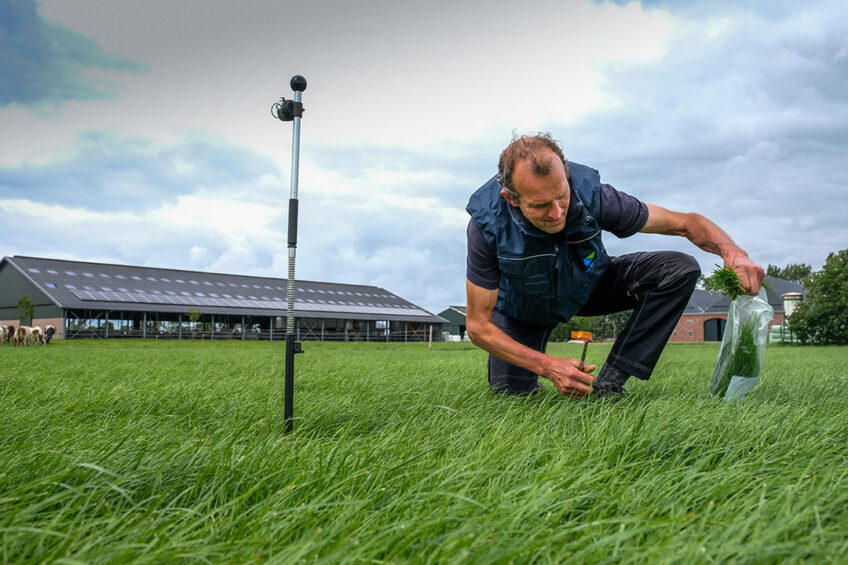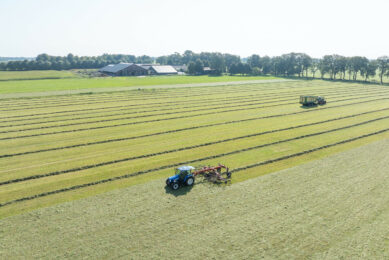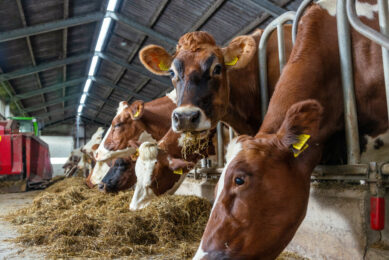Making the most of a grass-oriented farm

Wout Huijzer and Nely Schutte maintain a tight pasturing schedule. They aim to make the most of their 100% grass-oriented farm.
“When the cows go outside, they need to start eating right away.” This is what Wout Huijzer and Nely Schutte want to achieve. The dry cows that have just gone outside set the example. Just like the dairy cows, they get an extra strip of fresh grass every day. “They need to maintain this rhythm, even when they are dry.” The cows walk towards the fresh strip of grass and start eating immediately, almost one behind the other.

Pasturing starts in mid-March and ends somewhere in November, depending on the weather. In the first month, the dairy cows only go outside during the day. “We use about 20 out of the 52 available hectares for this purpose. We need to move quickly to get the different growth stages going. If we wait too long to get the cows outside, the grass gets too long for pasturing,” says Wout. And that, of course, is not why the pair aims for as much pasturing as possible. The spring grass needs to be used straight away for maximum yield. Wout and Nely say it’s an error in reasoning to think all the grass should be mowed before pasturing starts. “Why mow everything for silage first and feed it next? When the cows start pasturing here, we get the yield of the first grass in our bank account at the beginning of April,” says Nely.
Profile
Name: Wout Huijzer (55) and Nely Schutte (55) run the farm with their son Martijn (19).
Location: Dairy farm in Zeerijp, the Netherlands
Cows: On their farm they have 125 dairy and calf cows and 40 youngstock.
Farm: The 60 hectares of land consists of 100% grassland and they milk an average of 8,500kg of milk per cow with a milk fat percentage of 4.48% and a milk protein percentage of 3.61%.
We try to make money by optimising our fresh grass management.”
Yield
The cows’ annual ration is 25% fresh grass, 50% silage grass and the other 25% consists of concentrates. In absolute numbers, this amounts to 202,000 kilograms of dry matter from fresh grass. “Silaging costs us 10 cents per kilogram of dry matter. Compared to a farm that keeps its cows inside, it saves us € 20.000. If we use the first cut of those 20 hectares for silage, that still costs us € 4.000.” This way, they reduce feeding costs and produce milk at a lower-than-average overall cost. “We try to make money by optimising our fresh grass management.”
Ideal plot layout
The farm’s plot layout is ideal. The cows have access to about 1 hectare of fresh grass every day, depending on what’s available. Because all plots are 250 metres deep, the calculations are easy. Add 40 metres every day and divide that into 2 times 20 metres, so the cows get a fresh strip of grass after every milking. The back wire is moved with a delay, so that the entrance to the pasture with the fresh strip of grass can be kept close to the land that’s been grazed already. The cows first walk a few steps through the grazed grass, so they can ‘wipe their feet’. That way, the fresh strip is minimally soiled and stays fresh and tasty. To keep the cows walking, their water trough is located at the back of the plot. “It’s easier and more logical to install a drainpipe along the track, but that would result in the cows staying on one side of the strip. With the entrance along the track and the trough at the other side, we keep the animals moving,” Wout explains.

Rounds once a week
Once a week, Wout measures his plots with a grass-level meter. The data he obtains are sent to the computer. The farm has used feedwedge, from the Irish company AgriNet, for 4 years now. For the last 2 years, however, they’ve been using use the ‘Grip op Gras’ feedwedge, the measurements of which make a reasonable prediction of grass growth. Additionally, they regularly take a grass sample in collaboration with De Heus Voeders. Based on its analysis, Wout and Nely aim to achieve optimal urea content. “It’s a challenge to keep it around 20. Depending on the protein in the grass, we experiment with the protein levels in the concentrates.” Now, they use concentrates that contain only 110 grams of raw protein.

In order to maintain a low urea content, the grass should not contain too much protein. The only way to ensure this is through fertilisation. “That means we are continuously seeking a balance. On the one hand, you don’t want too much protein, but you also don’t want to give the cows so little that growth and yield are put under pressure.” The average grass yield in recent years has been around 11 tonnes of dry matter per hectare. In the more fertile years prior to that, the average was around 14 tonnes.

Only one silo bunker
The grass that is not pastured is used for silage. Huijzer and Schutte have a 40-metre-long and 10-metre-wide silo bunker. They use its contents for feeding between the beginning of October and the beginning of April. The remaining grass is baled. “We use the bales during the winter for the dry cows and the youngstock. It costs a little bit more, but we also feed the bales to the dairy cows in summer, in addition to pasturing.” Wout feeds about 3 kilogrammes of dry matter per cow per day. “That’s too little to get from silage, because it will lead to too much heat generation in the silage, causing mould. With the baled grass we can manage the feed requirements of the dairy cows. One moment you might choose a bale with a little more dry matter or structure, while you may need more protein-rich autumn grass at another moment. It’s a question of dotting the i’s and crossing the t’s.”
Join 13,000+ subscribers
Subscribe to our newsletter to stay updated about all the need-to-know content in the dairy sector, two times a week.










